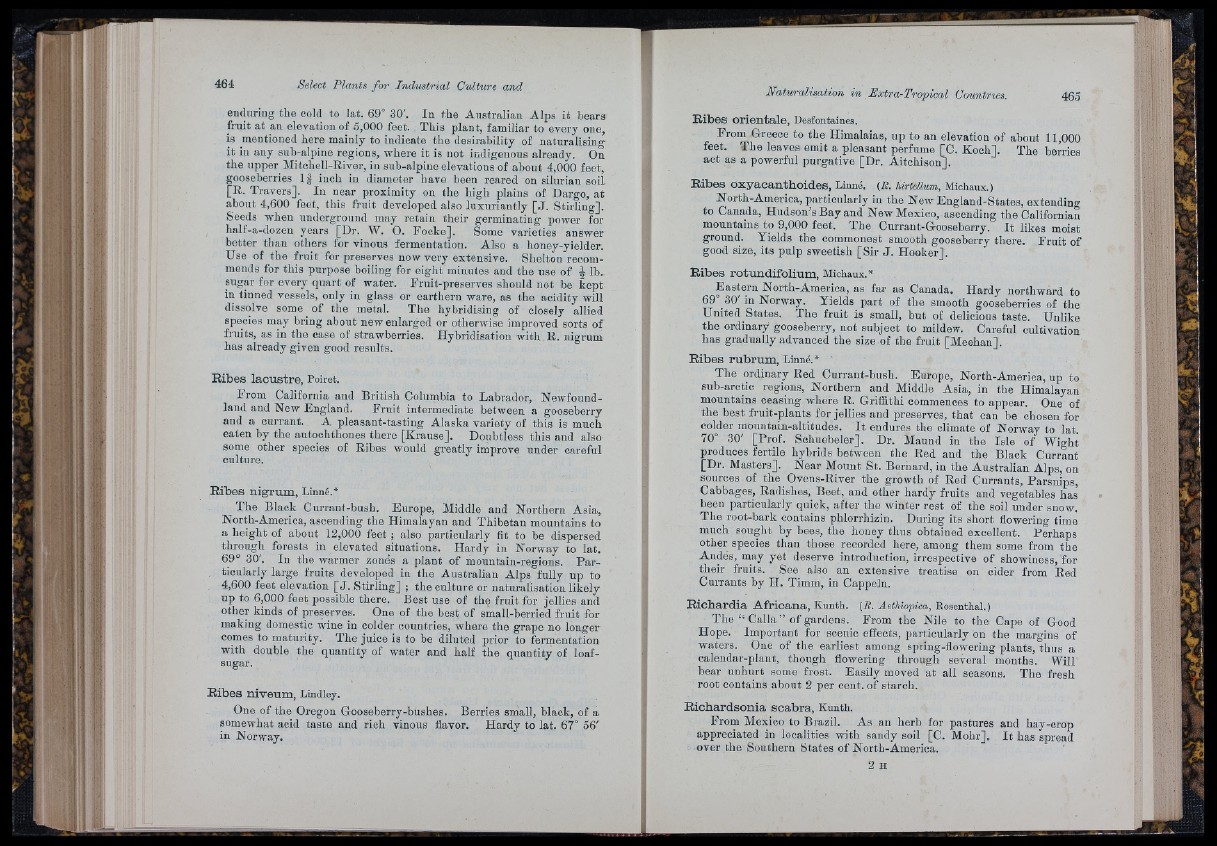
enduring the cold to Int. 69° 30'. In the Australian Alps it bears
fruit a t an elevation of 5,000 feet. 'This plant, familiar to every one,
is mentioned here mainly to indicate the desirability of naturalising
it iu any sub-alpine regions, where it is not indigenous already. On
the upper Mitchell-River, in sub-alpine elevations of about 4,000 feet,
gooseberries 1§ inch in diameter have been reared on Silurian soil
[R. Travers]. In near proximity on the high plains of Dargo, at
about 4,600 feet, this frnit developed also luxuriantly [ J . Stirling].
Seeds when underground may retain their germinating power for
half-a-dozen years [Dr. W. O. Focke]. Some varieties answer
better than others for vinous fermentation. Also a honey-yielder.
Use of the fruit for preserves now very extensive. Shelton recommends
for this purpose boiling for eight minutes and the use of L lb.
sugar for every quart of water. Fruit-preserves should not be kept
in tinned vessels, only in glass or eartliern ware, as the acidity will
dissolve some of the metal. The hybridising of closely allied
species may bring about new enlarged or otherwise improved sorts of
fruits, as in the case of strawberries. Hybridisation with R. nigrum
has already given good results.
R ib e s la c u s t r e , Poiret.
From California and British Columbia to Labrador, Newfoundland
and New England. Fru it intermediate between a gooseberry
and a currant. A pleasant-tasting Alaska variety of this is much
eaten by the autochthones there [Krause]. Doubtless this and also
some other species of Ribes would greatly improve under careful
culture.
R ib e s n ig r u m , Linné.*
The Black Currant-bush. Europe, Middle and Northern Asia,
North-America, ascending the Himalayan and Thibetan mountains to
a height of about 12,000 feet ; also particularly fit to be dispersed
through forests in elevated situations. Hardy in Norway to lat.
69° 30'. In the warmer zones a plant of mountain-regions. P a rticularly
large fruits developed in the Australian Alps fully up to
4,600 feet elevation [ J . Stirling] ; the culture or naturalisation likely
up to 6,000 feet possible there. Best nse of the fruit for Jellies and
other kinds of preserves. Cne of the best of small-berried fruit for
making domestic wine in colder countries, where the grape no longer
comes to maturity. The juice is to be diluted prior to fermentation
with double the quantity of water and half the quantity of loaf-
sugar.
R ib e s n iv e um , Lindley.
Cne of the Cregon Gooseberry-bushes. Berries small, black, of a
somewhat acid taste and rich vinous flavor. Hardy to lat. 67° 66'
in Norway.
R ib e s o r i e n t a l e , Desfontaines.
From Greece to the Himalaias, up to an elevation of about 11 000
feet. The leaves emit a pleasant perfume [C. Koch]. The beiries
act as a powerful purgative [Dr. Aitchison].
R ib e s o x y a c a n tb o id e s , Linné. (R. Mrtdlum, Michaux.)
North-America, particularly in the New England-States, extending
to Canada, Hudson’s Bay and New Mexico, ascending the Californian
mountains to 9,000 feet. The Currant-Gooseberry. I t likes moist
ground. Yields the commonest smooth gooseberry there. Fruit of
good size, its pulp sweetish [Sir J . Hooker].
R ib e s r o tu n d if o l iu m , Miohaux.*
Eastern North-America, as far as Canada. Hardy northward to
69°_30' in Norway. Yields part of the smooth gooseberries of the
United States. The fruit is small, but of delicious taste. Unlike
the ordinary gooseberry, not subject to mildew. Careful cultivation
has gradually advanced the size of the fruit [Meehan].
R ib e s ru ta rum , Linné.* '
The ordinary Red Currant-bush. Europe, North-America, up to
sub-arctic regions. Northern and Middle Asia, in the Himalayan
mountains ceasing where R. Griffithi commences to appear. One of
the best fruit-plants for jellies and preserves, th a t can be chosen for
colder mountaiu-altitudes. I t endures the climate of Norway to lat.
70° 30' [Prof. Schuebeler]. Dr. Maund in the Isle of Wight
produces fertile hybrids between the Red and the Black Currant
[Dr. Masters]. Near Mount St. Bernard, in the Australian Alps, ou
sources of the Cvens-River the growth of Red Currants, Parsnips,
Cabbages, Radishes, Beet, and other hardy fruits and vegetables has'
been particularly quick, after the winter rest of the soil under snow.
The root-bark contains phlorrhizin. During its short flowering time
much souglit by bees, the honey thus obtained excellent. Perhaps
other species than those recorded here, among them some from the
Andes, may yet deserve introduction, irrespective of showiness, for
their fruits. See also an extensive treatise ou cider from Red
Currants by H. Timm, in Cappeln.
R io b a r d i a A f r i c a n a , Kunth. (R. AetUopica, Rosenthal.)
'The “ C a lla ” of gardens. From the Nile to the Cape of Good
Hope. Important for scenic efEects, particularly on tlie margins of
waters. Cne of the earliest among spring-flowering plants, thus a
calendar-plant, though flowering through several months. Will
bear unhurt some frost. Easily moved at all seasons. The fresh
root contains about 2 per cent, of starch.
R i c b a r d s o n i a s o a b r a , Kunth.
From Mexico to Brazil. As an herb for pastures and hay-crop
appreciated in localities with sandy soil [C. Mohr]. I t has spread
over the Southern States of North-America.